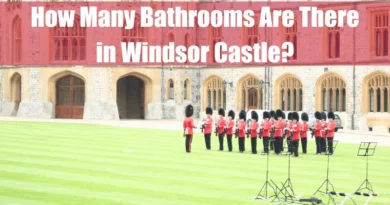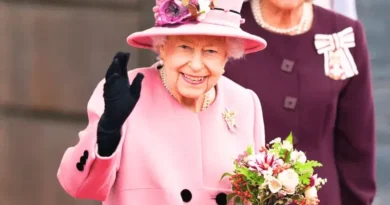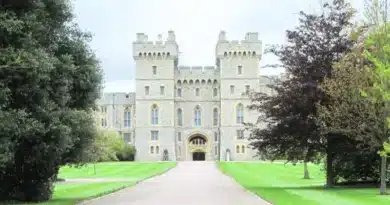How Many Rooms Are There In Windsor Castle?
Windsor Castle, located in Berkshire, England, is the world’s largest and oldest occupied castle. It contains over 1,000 rooms, including state apartments, private residences, and service areas. These rooms span across its extensive grounds, which cover about 13 acres. The castle has been a royal residence for over 900 years and remains an important location for state occasions and royal events.
Important Rooms in Windsor Castle: A Detailed Overview
Windsor Castle is the largest inhabited castle in the world and a repository of centuries of British history and royal grandeur. Each room in the castle has a unique purpose and significance, showcasing art, architecture, and royal tradition in unparalleled detail. Below is a complete exploration of the key rooms without omitting any aspect.
1. The State Apartments
The State Apartments are among the grandest rooms in Windsor Castle. Originally modernized during the reign of Charles II, they reflect the height of Baroque luxury.
- Grand Reception Room:
Known for its opulent gold detailing and sparkling chandeliers, the Grand Reception Room was once the primary ballroom of the castle. Its gilded plaster ceiling was painstakingly reconstructed after the 1992 fire. The room also showcases masterpieces from the Royal Collection, including works by Van Dyck and Rubens. - King’s Bedchamber:
This formal space was historically used by monarchs to meet advisers and discuss significant matters of state. The room is lavishly adorned with red damask walls and a plaster ceiling displaying the Stuart coat of arms. A magnificent, elaborately carved bed and rare artworks add to its regal aura. - King’s Drawing Room:
Often referred to as the “Rubens Room,” this room houses numerous paintings by Peter Paul Rubens, including a striking depiction of the Holy Family. It served as a reception area during the reign of Charles II, hosting guests and court assemblies.

2. The Semi-State Rooms
These private rooms, designed for George IV, are known for their theatrical grandeur. Severely damaged during the 1992 fire, the Semi-State Rooms have been restored to their original splendour.
- Crimson Drawing Room:
This room has luxurious red damask walls, gold-leafed furnishings, and state portraits. It also features exquisite furniture crafted by Morel and Seddon, making it one of the most lavish rooms in the Semi-State suite. - Green Drawing Room:
Initially intended as a library, this room features intricate furnishings and a stunning collection of Sevres porcelain originally owned by Louis XVI. Its long layout and central bay window highlight George IV’s French elegance and opulence preference.
3. St. George’s Hall

This grand hall is where state banquets and official events are held.
- The vaulted ceiling is adorned with emblems of the Knights of the Garter, including blank shields representing knights dishonoured for treason, particularly during the Tudor period.
- Above the hall’s two doors hang portraits of Queens Mary and Anne.
- At the far end, the Queen’s Guard Chamber showcases weapons and busts of British war heroes, including Nelson and Churchill.
When state banquets take place, microphones are cleverly concealed within flower arrangements. The Queen would traditionally sit in front of a bust of Queen Victoria during such events.
4. The Waterloo Chamber

This room was created to celebrate the Allied victory over Napoleon at the Battle of Waterloo in 1815.
- It features portraits of prominent British and European figures associated with the conflict, many of which were painted by Sir Thomas Lawrence, court painter to George IV.
- The room is distinguished by its magnificent wooden ceiling and murals created during WWII for Princess Elizabeth and Princess Margaret when their paintings were relocated for safekeeping.
5. St. George’s Chapel
St. George’s Chapel, constructed in the late 15th century, is a masterpiece of Perpendicular Gothic architecture and the spiritual heart of Windsor Castle.
- The chapel has hosted numerous royal weddings, including that of Prince Harry and Meghan Markle in 2018.
- Its fan-vaulted nave is lined with banners of the Order of the Garter, while the choir seats are adorned with 800 gold panels honouring departed knights.
- It is the burial site of several monarchs, including Henry VIII, Jane Seymour, George VI, and Queen Elizabeth II. The Albert Memorial Chapel is dedicated to Prince Albert and features ornate mosaics and the sarcophagus of the Duke of Clarence.
6. Queen Mary’s Dolls’ House
This intricate miniature replica of a royal household was built for Queen Mary between 1921 and 1924.
- The Dolls’ House is a marvel of craftsmanship, complete with working electricity, running water, and functioning lifts designed by Sir Edwin Lutyens.
- It features miniature books, artworks, and furniture, all created by the leading artisans of the time.
7. The Garter Throne Room
This room is used for the investiture ceremonies of the Knights and Ladies of the Order of the Garter, Britain’s oldest order of chivalry.
- It contains the royal throne and a portrait of Queen Elizabeth II in her coronation robes. The room reflects the historical significance of the order and its ties to Windsor Castle.

8. The Queen’s Drawing Room
This room houses some of the finest Tudor and Stuart portraits, including:
- Van Dyck’s Charles I in Three Positions.
- A rare painting of Elizabeth I as a princess, attributed to William Scrots.
- A Holbein-esque portrait of Henry VIII.
The room underscores the castle’s rich collection of historical artwork.
9. Other Notable Rooms
- Queen’s Gallery:
This room displays portraits exclusively by Anthony van Dyck, including the renowned “Charles I on Horseback.” It served as Windsor Castle’s principal ballroom until the construction of the Grand Reception Room. - King’s Closet:
Decorated with mythological frescoes by Anthony Verrio, this room is filled with Renaissance artworks by Breughel, Cranach, and other notable painters. - King’s Dressing Room:
This room contains an impressive collection of Northern Renaissance paintings, including works by Holbein, Durer, and Bronzino.
Conclusion
Every room in Windsor Castle has a unique role and significance, offering a window into the world of royalty and the legacy of British history. From the ceremonial State Apartments to the intricate craftsmanship of Queen Mary’s Dolls’ House, the castle encapsulates centuries of tradition, grandeur, and cultural heritage.
FAQ
How many rooms does Windsor Castle have?
Windsor Castle boasts approximately 1,000 rooms, including State Apartments, private royal apartments, and staff accommodations. This vast number reflects its status as the largest occupied Castle in the world.
What are the State Apartments at Windsor Castle?
The State Apartments are a series of grand rooms used for official events and ceremonies. Lavishly decorated, they showcase a superb and unrivalled sequence of rooms widely regarded as the finest and most complete expression of later Georgian taste.
Can visitors access the Semi-State Rooms?
Yes, the Semi-State Rooms, created for George IV, feature some of the most richly decorated interiors in the Castle. They are usually open to visitors from autumn to spring each year.
What is Queen Mary’s Dolls’ House?
Queen Mary’s Dolls’ House is a remarkable miniature residence at Windsor Castle. It showcases Edwardian life in intricate detail and is a popular attraction for visitors.
What is the significance of the Crimson Drawing Room?
The Crimson Drawing Room is a Semi-State Room used regularly by the Queen for private events, boasting spectacular views across the Berkshire countryside. It is open to visitors for part of the year.
What can be seen in the Grand Reception Room?
The Grand Reception Room is one of Windsor Castle’s most striking rooms, known for its opulent decoration and grandeur. It was notably damaged during the 1992 fire but has since been restored.
What is the Waterloo Chamber?
The Waterloo Chamber is an imposing room celebrating the defeat of Napoleon at the Battle of Waterloo. It is one of the busiest rooms at Windsor Castle and is open to visitors.
What is the Green Drawing Room known for?
The Green Drawing Room is part of the State Apartments and showcases exquisite furnishings and artworks. It reflects George IV’s taste for fine objects and theatrical interiors.
What is the White Drawing Room used for?
The White Drawing Room is another elegant space within the State Apartments, used for official entertaining and adorned with fine art and furnishings.
What is the King’s Bedchamber?
The King’s Bedchamber is a historic room within Windsor Castle, traditionally used by reigning monarchs. It is part of the State Apartments and reflects the opulent style of the period.
What events are held in the Queen’s Ballroom?
The Queen’s Ballroom is a grand space within Windsor Castle, used for state banquets and official functions. It showcases magnificent chandeliers and ornate decorations.
What is unique about the Octagon Room?
The Octagon Room is an architecturally unique room within Windsor Castle, known for its distinctive shape and design. It houses a fine art collection and is part of the visitor route.
What is the Garter Throne Room?
The Garter Throne Room is used for ceremonial occasions, particularly related to the Order of the Garter. It features the throne and is adorned with symbols of the order.
What is the purpose of the State Dining Room?
The State Dining Room is where formal dinners and banquets are held. It is richly decorated and showcases the grandeur of Windsor Castle’s interior.
Is there a Private Chapel in Windsor Castle?
Yes, the Private Chapel is a place of worship within Windsor Castle, used by the royal family. It reflects the monarchy’s religious heritage and is part of the Castle’s private quarters.
What can be found in the China Museum?
The China Museum is part of the State Apartments and is open to visitors. It houses a vast collection of porcelain and ceramics collected by the royal family over centuries.
What is the Royal Library?
The Royal Library, located within Windsor Castle, contains a significant collection of books and manuscripts belonging to the royal family. It reflects the intellectual pursuits of the monarchy.
What views does the North Terrace offer?
The North Terrace offers panoramic views of the surrounding landscape and is part of the visitor experience at Windsor Castle. It provides a vantage point to appreciate the Castle’s setting.
What is the significance of the Grand Staircase?
The Grand Staircase is an impressive architectural feature within Windsor Castle, leading to the State Apartments. It is adorned with portraits and serves as a grand entrance for official events.
What is displayed in the Guard Chamber?
The Guard Chamber is a historic room where the Castle’s guards were stationed. It now displays a collection of arms and armour, reflecting the military history.









